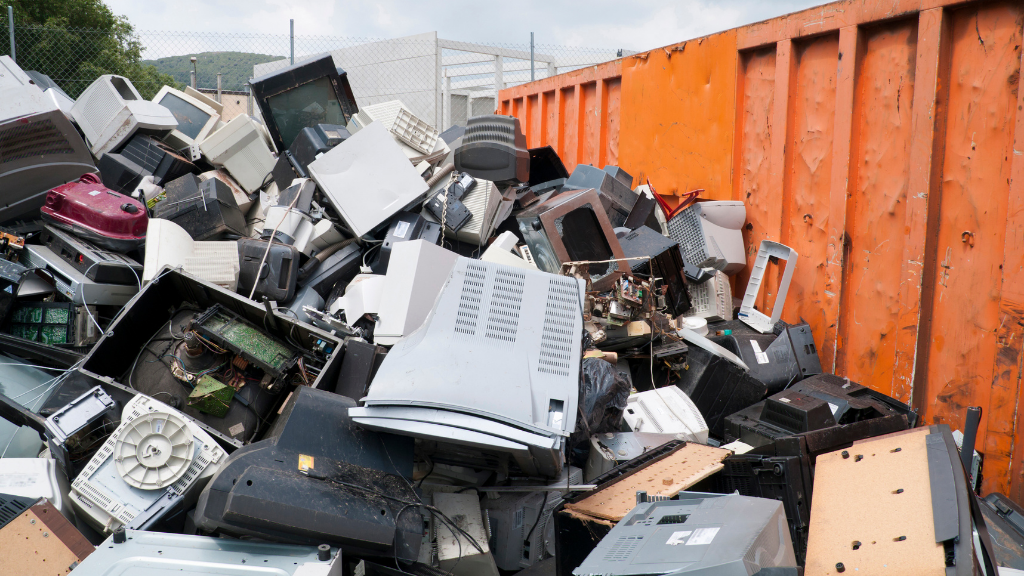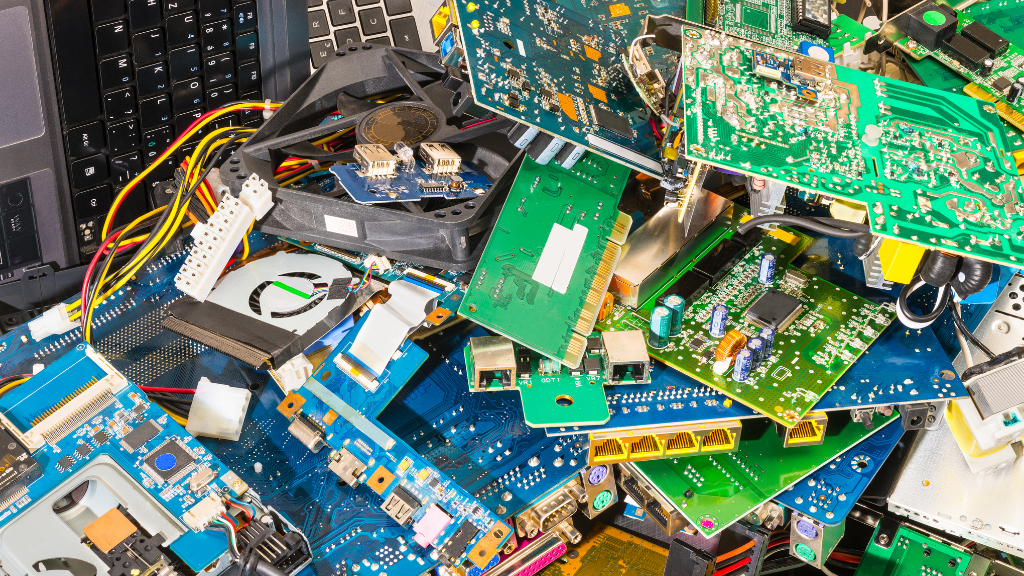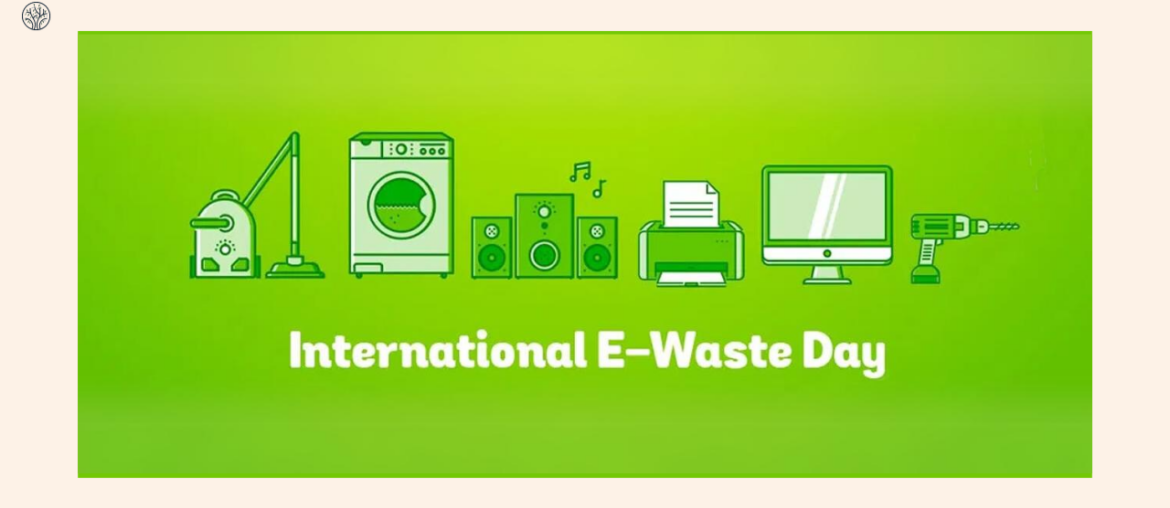Only 17.4% of the world’s e-waste was properly recycled, while the rest was dumped in landfills, causing harm to the environment and human health.
To raise awareness and action on this issue, the WEEE Forum, a European association of e-waste collection and recycling organizations, launched the International E-Waste Day. This International E-Waste Day 2023 will be the 6th annual celebration of the event.
What is E-Waste?
E-waste is any electronic device that has reached the end of its life. It includes a wide range of products, such as computers, laptops, tablets, smartphones, TVs, etc.

According to the Global E-waste Monitor, e-waste is the fastest-growing waste stream in the world, with an estimated growth rate of 3% per year. In 2019, the global generation of e-waste reached a record 53.6 million tonnes, equivalent to the weight of 350 cruise ships.
Why is E-Waste a Problem?
E-waste is a problem for several reasons. First, it contains valuable materials and metals, that can be reused, saving natural resources, and energy. For example, 1 tonne of circuit boards can have 800 times more gold than 1 tonne of gold ore.

Second, e-waste also contains hazardous substances, such as lead, mercury, cadmium,… that can harm human health and the environment if not properly handled. These substances can leach into the soil and water, contaminate the food chain, and cause various diseases, such as cancer, neurological disorders, respiratory problems, reproductive issues, and birth defects.
Third, developed countries often export e-waste to developing countries. There, it will be processed in informal and unsafe ways, exposing workers and communities to toxic chemicals and pollutants.
According to the Basel Convention, an international treaty that regulates the transboundary movements of hazardous wastes, e-waste should not be exported without the prior consent of the importing country and without ensuring environmentally sound management.
However, many countries do not comply with these rules and use loopholes or illegal methods to ship their e-waste abroad, often under the pretext of donating or reusing second-hand equipment.
International E-Waste Day’s History
The first International E-Waste Day was held in 2018 and involved 30 countries from six continents. The main goal was to increase the visibility of e-waste and encourage consumers to dispose of their old or broken devices at recycling facilities.
The following year, the event expanded to 40 countries and focused on the theme of “education”. It aimed to inform and inspire students, teachers, and parents about the impacts of e-waste and how they can prevent it.
In 2020, the event grew even further, with participation from 50 countries. The chosen theme for this edition was “e-waste and climate change.” Through this event, the WEEE Forum hoped to inform and inspire people about the environmental and social impacts of e-waste and how they can prevent and treat it properly.
Fast forward to 2021, the focus shifted towards individual responsibility. The event highlighted the pivotal role each of us plays in transforming the concept of circularity into a reality for electronic products.
In 2022, International E-Waste Day zoomed in on the world of small electronic items under the slogan ‘Recycle it all, no matter how small!’. It was a reminder that every electronic device, no matter its size, deserves responsible disposal.
So what will be the theme for International E-Waste Day 2023?
International E-Waste Day 2023 Theme
The theme of International E-Waste Day 2023 is “How to Recycle Anything with Plug, Battery, or Cable”. The aim is to highlight the issue of “invisible e-waste”.
A study in 2022 by UNITAR and WEEE Forum members in six countries (UK, Italy, Portugal, Romania, Slovenia, and The Netherlands) found that an average household has 74 e-products, but 13 of them are not in use with 70% of those are still working and only 30% are unusable.
These products are mostly small consumer electronics and accessories, such as headphones or remote controls. Many people do not realize that these items are electronic and can be recycled.
How to Recycle E-Waste?
Recycling e-waste is not only a duty but also a legal obligation in many countries. The European Union, for example, has adopted the Waste Electrical and Electronic Equipment (WEEE) Directive. It requires producers and consumers of electronic products to collect and recycle their e-waste according to specific targets and standards. Other countries, such as Japan, South Korea, China, India, and the United States, have also introduced similar regulations or initiatives to promote e-waste recycling.
However, recycling e-waste is not as simple as throwing it in a bin. It requires a complex process that involves several steps. Each step requires specific equipment, skills, and safety measures to ensure the quality and efficiency of the recycling process and to protect the workers and the environment from potential hazards.
Therefore, the best way to recycle e-waste is to trust a certified and responsible recycler. There are many ways to find a reliable e-waste recycler near you, such as:
- Checking the websites of your local authorities, environmental agencies, or waste management companies.
- Visiting the websites of the manufacturers or retailers of your electronic products, you can find information on their take-back or buy-back programs, which allow you to return or exchange your old or unwanted devices for recycling, reuse, or reward.
- Searching online for e-waste recyclers in your area, using directories, databases, or maps, such as the ones provided by the WEEE Forum, the International Telecommunication Union, or the Basel Action Network. However, make sure to verify the credentials and reputation of the recycler before handing over your e-waste, as some may not comply with environmental and social standards or may export your e-waste to developing countries.
You can also consider a zero-waste lifestyle by reducing, reusing, and recycling so that we will send nothing to the landfill.
Join International E-Waste Day 203 today!
International E-Waste Day is a global event that aims to raise awareness about the problem of e-waste. Last year, 194 organizations from 72 countries across six continents joined the event. This year, #ewasteday will take place on October 14, 2023, and you can become part of it.
You can register to participate in the International E-Waste Day 2023 here.
Frequently Asked Questions About E-Waste
1. What is invisible e-waste?
Invisible e-waste is electronic waste that goes unnoticed due to its nature or appearance. As mentioned above, invisible e-waste refers to electronic items that have a plug, a battery, or a cable but are not usually considered e-waste. Invisible e-waste represents a large and growing proportion of the total e-waste generated worldwide, estimated at 61.3 million tonnes in 2023.
2. How does e-waste affect people’s health?
E-waste contains a mixture of harmful substances and precious materials that can pose risks to human health if not properly collected, treated, and recycled. These substances can contaminate the soil, water, and air, and enter the food chain and the human body.
Exposure to e-waste can cause acute and chronic effects, such as skin irritation, respiratory problems, digestive disorders, and cancer.
3. Which countries dump the most e-waste?
According to the Statista, the top 10 countries that generated the most e-waste in 2019 were:
- China (10.1 million tonnes)
- The United States (6.9 million tonnes)
- India (3.2 million tonnes)
- Japan (2.9 million tonnes)
- Germany (2.6 million tonnes)
- Russia (2.4 million tonnes)
- Brazil (2.1 million tonnes)
- Indonesia (2.0 million tonnes)
- France (1.9 million tonnes)
- The United Kingdom (1.8 million tonnes).
4. What is International E-Waste Day?
International E-Waste Day is a yearly awareness-raising celebration initiated by the WEEE Forum and its members. This event takes place every year on October 14. It aims to highlight the growing issue of electronic waste and promote responsible e-waste management.
The International E-Waste Day 2023 theme is “How to Recycle Anything with Plug, Battery, or Cable”
5. Why is e-waste sent to developing countries?
E-waste is sent to developing countries for various reasons, mainly economic and regulatory. Mostly because developing countries have:
- High demand for cheap and second-hand electronic devices.
- Low cost of labor and disposal, compared to the cost of recycling in developed countries.
- Weak regulation and enforcement of e-waste management.
6. Where to recycle E-Waste?
The best way to recycle e-waste is to bring it to the nearest collection point or recycling facility. Depending on your country and region, there are different options and systems for e-waste collection and recycling.
To find out the best option for recycling e-waste in your area, you can check the websites of your local authorities, or your e-waste recycling organizations.
7. What are circular economies for electronic equipment?
Circular economies for electronic equipment are systems that aim to minimize the generation of e-waste and maximize the value and the lifespan of electronic devices, by applying the principles of reduce, reuse, and recycle.
In a circular economy, electronic devices are designed to be durable, repairable, upgradable, and recyclable, and are used as long as possible.
According to the United Nations, the lack of public awareness is preventing countries from developing circular economies for electronic equipment, and recommended the following actions to overcome this barrier:
- Developing and implementing national and regional strategies and policies for e-waste management.
- Increasing and improving the communication and education on e-waste and circular economy for electronic equipment.
- Engaging the public and the private sector in e-waste and circular economy for electronic equipment.









